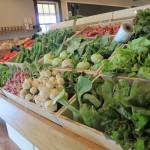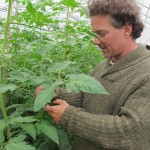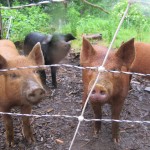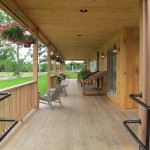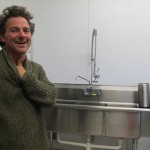Growing Pains: What One N.H. Farmer Is Doing To Make Local Food More Profitable
- Heron Pond Farm sells produce and other goods at their farm stand in Kensington, N.H.
- Cantelmo says having a freezer allows him to over produce during peak season, increasing consistency at his farm stand.
- Pigs at Pheonix Hill Farm in Boscawen, where Ryan Ferdinand and Mike Hvizda live and work.
- Mike Hvizda and Ryan Ferdinand are farmers and artists in Boscawen. Because farming is so costly, however, they are scaling back to focus on careers as realtors.
- Heron Pond farm stand, Kensington, N.H.
- Andre Cantelmo says selling value-added processed foods like pesto, made in an industrial kitchen, can help increase profits for produce all around.
With almost 60 farmers markets across the state, demand for local food is growing. But local farmers still struggle to make a profit growing local food. In fact, about three quarters of all farms in New Hampshire gross less than $10,000 from sales each year.
This is the first installment in our summer business series investigating how a changing market place is affecting New Hampshire farmers.
At the Concord Farmers’ Market on a Wednesday evening in July, an older woman peers over a table at some whimsical looking vegetables shaped like a curlicues. She asks a young farmer standing behind the table what to do with them. “You just put it wherever you’d use garlic, or chives,” the farmer explains. “They’re good.”
This is the first summer Concord has had not one, but two farmers’ markets. And over in Durham, the farmers market has gone from five to 25 vendors in just a few years. So while there’s little hard data, there’s also little doubt: consumer demand for local meat and produce is growing.
You might think that all that demand would lead to at least family-sustaining profits for local farmers, but Agriculture commissioner Lorraine Merrill says profitability is “the biggest challenge” to farm sustainability.
Young farming couple Mike Hvizda (pronounced “Vizda”) and Ryan Ferdinand are greeted by a chorus of pigs and ducks on their farm in Boscawen. But they’ve not only kept their day jobs. They’re scaling their farm back. The money, Vizda says, just isn’t there:
You’re working at profit margins that a grocer or a lawyer or a car mechanic would just absolutely laugh at, they just wouldn’t try to sell something at that kind of margin.
Commissioner Merrill explains land here is expensive, and labor too, but most of all, New Hampshire farms are just too small to take advantage of the economies of scale farms enjoy further west.
Which means meat and produce grown here often aren’t consistent in quality, or consistently available, or convenient for consumers.
It smells like sawdust and strawberries at the Heron Pond Farm stand, a large wooden cabin at the junction of 150 and 107 in Kensington, near the New Hampshire seacoast.
Here, Andre Cantelmo is trying to change the face of farming in New Hampshire with two $16,000 Cryovac freezers, and an industrial kitchen, which grants from the New Hampshire Community Loan Fund and the Fair Food Network helped him afford. He says he is developing a “model for farms to say ‘this is the maximum way to transfer your surplus into dollars.’”
Inside a 33 degree freezer in the basement of his souped-up farm stand, Cantelmo explains how the freezers increase profits by increasing efficiency.
Take strawberries, for example. It’s not like you harvest the same number of strawberries each day throughout the season: the harvest starts slowly, peaks, then peters out. “You either have way too many or not enough,” he says.
Cantelmo knows he can get more customers to his store if he stocks more than enough strawberries for as long as possible. So he has to over produce during peak season. Same goes for tomatoes. Ordinarily, you have to throw out the extra tomatoes.
But with the freezer, Cantelmo can over produce for fresh produce sales, and still profit from what’s left over – by selling it frozen.
Of course frozen food isn’t exactly what you picture at a farmers market, but Cantelmo is sure his frozen local strawberries, tomatoes and beans will be a big hit come January.
Everything is chrome-colored, and shiny-new in Cantelmo’s industrial kitchen. He says the first thing he’s going to do here is make pesto with garlic scapes — those green curlicue-shaped things at the farmers market.
Garlic scapes have to be cut, he says, because if you leave them on the plant the garlic bulb doesn’t grow as big. By processing what would be discarded into a value-added product, Cantelmo says, he “introduces people to a new thing, and is also something that increases the profit of the garlic crop overall.”
From his office at the New Hampshire Community Loan Fund in Concord, John Hamilton helped get Cantelmo a grant for the farm stand project. As demand spikes for local food, Hamilton says, everyone is talking about “going to scale.” But, he says, “it’s a hackneyed phrase. You don’t do it just because there is demand but it has to fit with your business and you don’t want to take on too much risk.”
Scaling up in the traditional sense, Hamilton explains, might not be the best choice for farmers in a small state with small quantities of noncontiguous farmland. That’s why nearby cheese makers, bread bakers and beer brewers will also be stocking their products at the Heron Pond farm stand. Hamilton says being open to new ideas and collaboration is the best way a farmer like Cantelmo can woo customers away from the bright glow of a supermarket to a Lincoln-log style farm stand on the corner of two state roads.
